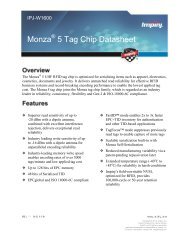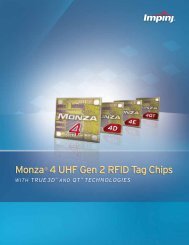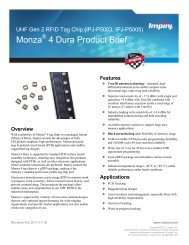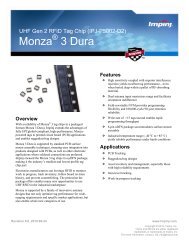Indy R1000 Datasheet - Impinj
Indy R1000 Datasheet - Impinj
Indy R1000 Datasheet - Impinj
You also want an ePaper? Increase the reach of your titles
YUMPU automatically turns print PDFs into web optimized ePapers that Google loves.
<strong>Indy</strong> <strong>R1000</strong> ® Electrical, Mechanical, & Thermal Specification<br />
5.1.2 LO Input<br />
The RX LO may be sourced internally or externally as shown in Figure 6. If an external RX LO is not used, the DC blocking capacitors, inductor,<br />
and balun are not required.<br />
5.1.3 Receive RF Interface<br />
Figure 6: LO Input External Interfaces<br />
The <strong>Indy</strong> <strong>R1000</strong> reader chip has differential RF and LO ports to alleviate interference on the package bond-wires coming from the digital section of<br />
the chip.<br />
The <strong>Indy</strong> <strong>R1000</strong> RX Mixer also supports a high gain and a low gain mode with differing compression points. In order to switch between these<br />
modes, it is necessary to both correctly program the ANA_CTRL1 register as well as bias the output of the mixer to +3.3v through 400 ohm<br />
resistors. These resistors may be switched in for low gain mode and out for high gain mode. Ensure that when switched out, these bias resistors do<br />
not create an unintended current summing node.<br />
5.1.4 Receive Baseband Interface<br />
An AC coupling interface is used in the <strong>Indy</strong> <strong>R1000</strong> reader chip between the mixer and the baseband low noise amplifier. This interface provides a<br />
high-pass filtering response to notch out the DC offset generated by the self-jamming signal from the transmitter.<br />
The design of the baseband interface meets the following requirements:<br />
• The high-pass filtering corner must be low enough to not attenuate the received signal. Although the tag response modulation does not consist<br />
of any DC content, the low data rate modes can have significant signal contents very close to DC<br />
• The high-pass filtering corner must be high enough so that the DC changes can converge quickly enough. There is a change of DC content<br />
going from modulated data transmission (interrogator transmit) to continuous wave (CW) transmission (interrogator receive.) The DC changes<br />
need to converge before the receive demodulator can demodulate correctly. The DC level change occurs during transition from transmit to<br />
receive. Varying the time constant of the high-pass filtering or sampling and holding the DC offset is allowed, provided the air interface<br />
protocol is not violated.<br />
• The AC coupling capacitor and the bias resistance must form a low-pass filter for the bias thermal noise, provided the total integrated noise is a<br />
constant equal to KT/C. To reduce the input referred noise of the baseband low noise amplifier, either make the corner frequency high to lower<br />
the in-channel spectral noise density, or make the corner frequency lower than the high-pass filtering in the baseband filter chain.<br />
16 Revision 2.3, Copyright © 2012, <strong>Impinj</strong>, Inc.







